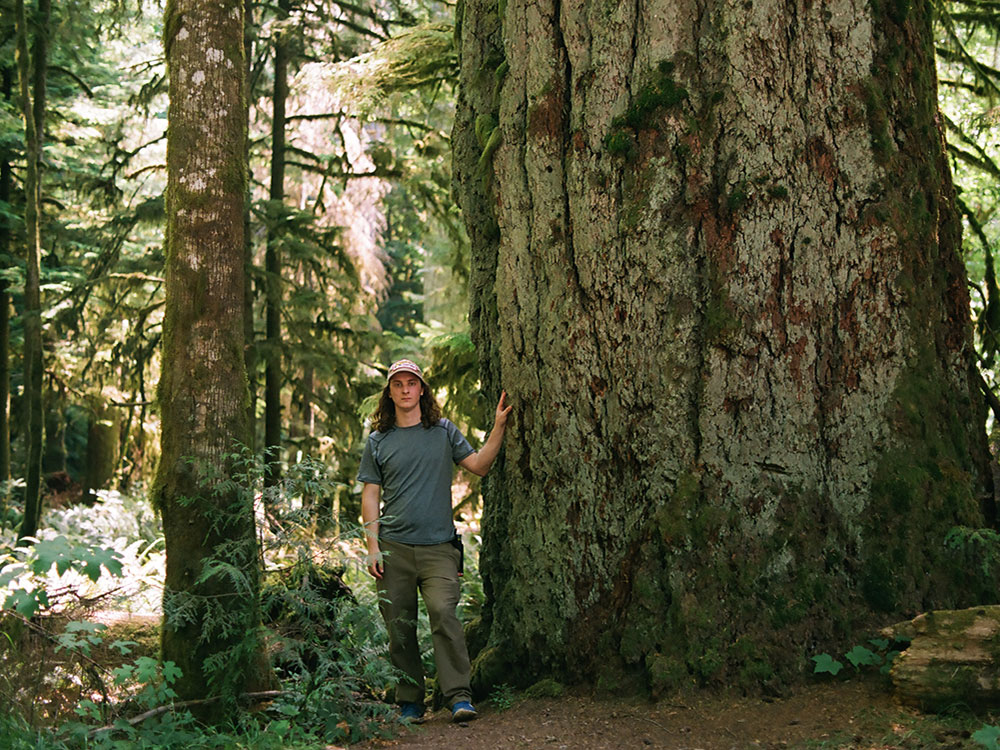On the afternoon of June 19 in the foggy depths of old-growth forest, Colin Spratt finally found what he was looking for: a 2,000 year-old western red cedar.
The north shore giant stood in a clearing in the remote reaches of Lynn Headwaters Regional Park. The 5.8 metre-thick base of the tree was hollow; its labyrinth of roots, each one wider than a human body, extended outwards and into the surrounding earth. Early estimates by Spratt and fellow expeditioner Ian Thomas show that the cedar might be the fourth-widest known tree in Canada, its trunk “nearly as wide as the cabin of a Boeing 747 airplane.”
Spratt’s hunt for the cedar had started 10 hours earlier. It was the peak of a gruelling pilgrimage through thick, unforgiving undergrowth. But it also had its roots in a lifestyle that began 40 years before when a single man, Randy Stoltmann, decided to begin locating and registering B.C.’s biggest trees.
Today, Stoltmann’s legacy extends to the BC BigTree Registry. And it also extends to the people carrying on his work: there are now between 10 and 15 big-tree hunters in the province. For this issue of our series, “A Day in the Life,” we interviewed the group’s youngest and newest recruit: Colin Spratt.
The following interview has been edited for length and clarity.
The Tyee: When did you become a big-tree hunter?
Colin Spratt: During the pandemic, I found myself cycling around Stanley Park and I just started bumping into these magnificently large trees I had no clue were in the park. That set off a chain reaction. And once your eye wanders away from Stanley Park it’s an endless thing…
So, what is the process of big-tree hunting? Where, how and when does the hunt begin?
It starts with a myth, a legend or a tall tale. The knowledge of an area that wasn’t clear cut. It could be a really tantalizing satellite image, where you see a little section that didn’t get logged. And then it's a matter of getting to the area and taking the time to fully explore it.
The hardest thing is getting into these places, and getting out of there before the sun sets. These are very treacherous landscapes. So the planning is basically, “How far are we going to push it before we turn back?” But your instinct is to keep going until you find something. But that’s not always wise. These aren’t places you wanna be when there’s no light.
But if the sun never went down, I don’t think there would be an end. I don’t think I’d be speaking to you right now. I’d probably be out there.
What makes these old-growth forests so dangerous?
There are trees that are five metres wide that have fallen over and stacked upon each other. There are blackberry bushes, cliffs and in Lynn Valley there are mine shafts you can fall down. There’s an endless amount of physical obstacles.
What gear do you carry when heading out on an expedition? What’s in the survival backpack?
In my backpack I always carry a LifeStraw [a hand-held water tubular filtration device]. It allows me to drink from any creek or river. You also gotta have a first aid kit, pre-downloaded map and a satellite phone with an SOS button, because if anything goes wrong, it could take up to five to who-knows-how-many hours to get to you. But I also always carry a compass because at the end of the day, a satellite phone is just a piece of electronics so it can fail you.
I always carry a headlamp with extra batteries and then I have a flashlight I can hold in my hand. One light is not enough if you’re stuck in an area after the sun goes down.
I always carry with me my Lucky Film camera [from 1965] and only bring a single roll of film. It forces me to connect with nature and not obsessively take a million shots.
Oh, and I have bear spray.
What are you wearing on your body? What are your clothing essentials?
I always wear my lucky hat which is a green runner’s hat. And I’m Mr. Canadian Tire, so I’m wearing $30 Canadian Tire hiking boots and I carry a second pair in my backpack in case they fail. That’s because I trash the shoes regardless. I don’t want to trash $400 shoes. I was hiking once in Columbia boots and the sole came off. So I was basically bushwhacking in what felt like bare feet.
And then rain gear, tear-proof pants and lots of socks — that’s essential when hiking in the Pacific Northwest.
What is the most stressful part of big-tree hunting?
Worrying my mom. This is dangerous. These areas have salmonberry bushes 10 feet tall. If something happens to me in one of these areas, I might never be recovered. They might never find my body.
Randy Stoltmann, the legendary guy who founded the big tree registry, died at 32. He died skiing — he pushed too hard. And I just never want to put that on my family. I love my family just as much as I love these big trees. The ambition to get out into these forests and find greatness has to be balanced.
I don’t want to remove 20 years off my mom’s life.
Why risk it then? What’s driving you?
It can come down to this moment in Stanley Park. The sun was setting perfectly behind an old-growth Douglas fir. And all of a sudden I understood that this thing had been there 800 years. The landscape around it has transformed but the tree has just kept growing. And it’s just a miracle. And it’s so awe-inspiring that it's a bit addicting.
These trees the size of skyscrapers are just thriving, and it doesn’t matter if we see them or not. I mean, right now, as I speak to you, these trees are there. And that thought is in my brain when I go to sleep. It’s obsessive.
Why else would you slug through blackberry bushes for 10 hours, covered in cuts and bleeding and drinking out of a little muddy stream with a LifeStraw? It’s just suffering. But I know there is a tree out there bigger than any that’s been found, a tree that will change the textbook. And maybe I won’t find it in my lifetime. But I know there’s something bigger, and that’s what drives me.
How does it feel to stand in the shadow of a big tree?
It’s hard to put into words the amount of majesty and awe you feel when you see them.
These trees are in pristine wilderness. There’s almost this temple around them because they’ve sucked up all the light and they have this clearing underneath them that seems to be designed by a creator or something.
And it’s super weird because you can feel the trees sometimes before you go around the corner. And that’s part of what we’re chasing. That feeling. The magnetic energy of these trees.
I don’t want to sound like a religious fanatic, because I’m not religious, but I see God in these big trees. It’s this manifestation of the universe that you don’t see in a farmer’s field, and you don’t see going for a walk to the grocery store.
In the human gene we seek this... clarity. And it's there in the local mountain. There’s little vestiges of it left.
There are people out there who don’t get the value of old-growth forests. What do you wish they understood?
To me, it’s very simple. You don’t know what you care about until you’ve seen it and experienced it. So many of us go our whole lives without seeing an old-growth forest. So there is this complete disconnect. It took me until I was 26-years-old to realize what an old-growth forest is.
When someone says, “I don’t care about old growth, it’s just wood,” I want to throw them in the car, drive them to Lynn Valley, show them the trees and say “Do you still feel that way?” Ten times out of 10 it changes people.
How many big-tree hunters are there?
Only around 10 to 15 that I’m aware of. And we all know each other. It is a tight little group of people. And I think that’s because it’s not the easiest of hobbies and it's not leisurely. Getting out to Stanley Park is one thing. Getting to the remote tips of southern Vancouver Island is another thing.
What’s the future of big-tree hunting?
I’m hoping that in the future we will have a group of passionate, educated people who are adding to the database of trees. I mean, this isn’t just some pursuit of the biggest tree. That’s missing the idea fully. We’re trying to fill a map. A map that is blank. And we want that map for researchers who can go and ask the big questions, like “How did the heat dome affect this monumental grove of trees?”
I’m just hoping that the right people get into this and help add to that database and this bank of knowledge, which important people use to make important decisions.
Follow Spratt on Instagram as he journeys to find big trees. ![]()
Read more: Environment


















Tyee Commenting Guidelines
Comments that violate guidelines risk being deleted, and violations may result in a temporary or permanent user ban. Maintain the spirit of good conversation to stay in the discussion.
*Please note The Tyee is not a forum for spreading misinformation about COVID-19, denying its existence or minimizing its risk to public health.
Do:
Do not: